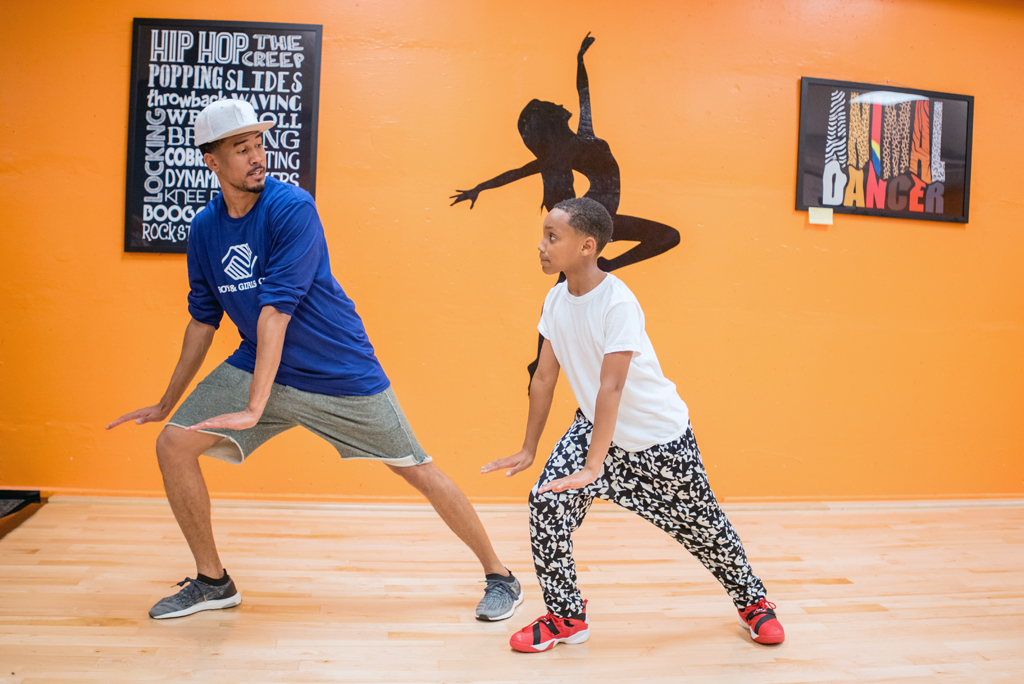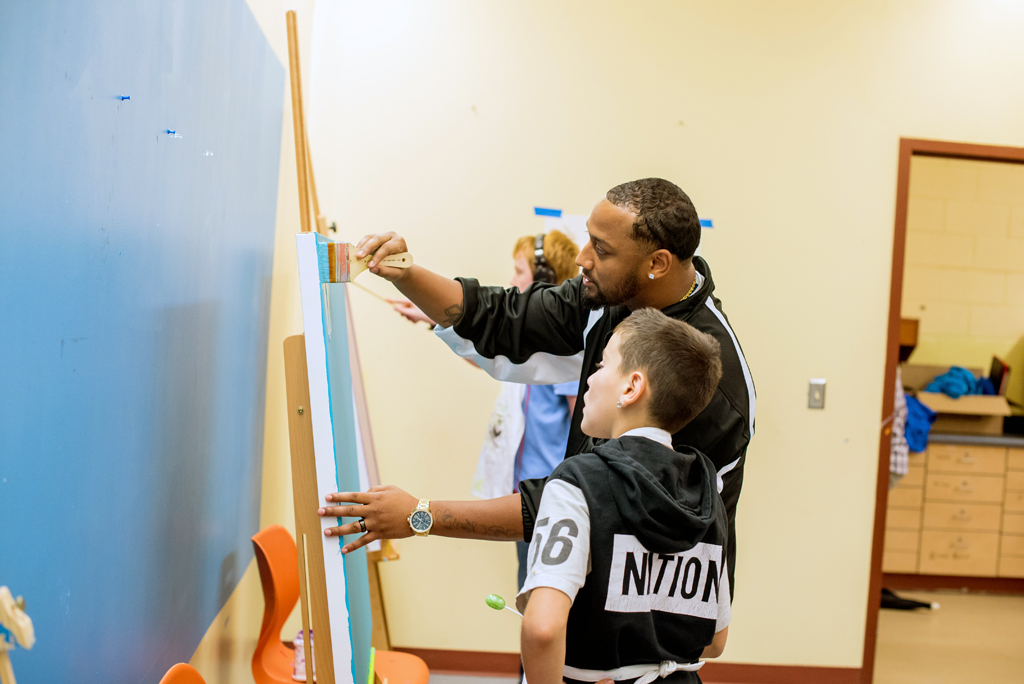Remember doing art projects with construction paper and Elmer’s Glue? We’ve all had that experience, but we know it usually doesn’t constitute a top-notch art program.
Many after-school providers would like to expand their arts activities into high-quality arts programming. But many feel the challenge is too great and some may feel it’s entirely undoable.
The Wallace Foundation begs to differ.
And so do the Boys & Girls Clubs of Greater Milwaukee.
Beginning in 2014, the Milwaukee organization took part in a Wallace-funded project to hire professional teaching artists and test the best practices formulated by Wallace in 2013.
Boys & Girls Clubs of Greater Milwaukee created a dance program and a mural painting program at one club site and a drawing class and videography class at another site.
Three of those programs are still going strong today.
One of the lessons learned is to hire professional artists who are both skilled in their field and already know how to work with the kids, said Laketta Caldwell, director of the arts at the Boys & Girls Clubs of Greater Milwaukee.
Some teaching artists “just weren’t a good fit,” she said. Artists have to be able to develop a relationship with youth in order to teach effectively, she said.
A Wallace Foundation report released in October, “Raising the Barre and Stretching the Canvas: Implementing High-Quality Arts Programming in a National Youth Serving Organization,” examined how large multipurpose youth organizations can best implement such programs. The goal is to offer high-quality arts experiences in after-school programs serving low-income youth who would not otherwise not have access to them.

Professional dancer and choreographer Cedric Gardner shows kids a dance move at the Sallie Davis Boys & Girls Club in Milwaukee. Kids in the program make a commitment of time and effort in order to participate.
The requirements
High-quality arts programs require professional artists with high expectations working with kids in dedicated spaces and a public commitment by executive directors of the organization, according to the Wallace Foundation.
They also require, according to the foundation:
- A public culminating event.
- Positive relationships with adult mentors.
- Youth input that actively shapes the program.
- Hands-on skill building.
- Engagement in the community that builds community support.
- Physical and emotional safety.
Large youth-serving organizations can meet these requirements, but implementation may mean some changes in the organization’s culture, the report said.
For example, a level of commitment was required that contrasted with the Boys & Girls Clubs’ flexible after-school drop-in environment. Clubs had to dedicate space for one use, in contrast with multipurpose use. And hiring higher-paid teaching artists was a departure from hiring generalist after-school staff. The artists had to be allowed more latitude in their jobs, which caused some tensions among staff, according to the report. Two of the Milwaukee organization’s 51 sites received special funding from Wallace, which caused tensions among the sites and staff, the report said.
The reward
But the payoff was high.
Children respond to a high-quality program that has high expectations, Caldwell said.
“It’s something they want,” she said. “They welcome it.”
Youth participation increased, she said. The report noted that the increased participation occurred at an age when club involvement typically begins to decline.
Professional dancer and choreographer Cedric Gardner teaches dance at the Don & Sallie Davis Boys & Girls Club. Kids practice four days a week in a professional dance studio. They are dedicated dancers, Caldwell said.
Mural artist Vedale Hill teaches art at the Davis club site and videographer James Gavins teaches video in a lab at the Fitzsimonds Boys & Girls Club, where kids can learn how to film, perform and edit.
“It really increased parent participation, especially in the dance program,” Caldwell said.
And public events to showcase the kids’ work “have been a great tool for us to publicize our program,” she said.
Other places
The Wallace Foundation also funded programs in Boys & Girls Clubs in Green Bay, Wisconsin, and in Minnesota as part of its 2½-year project to examine whether the clubs could put the necessary ingredients in place. Altogether, 929 kids were served, mostly age 11 or younger. Most were African-American or Latino. More girls chose to take part than boys, the report noted.

The Wallace Foundation’s pilot project the Youth Arts Initiative explored how selected Boys & Girls Club sites could implement 10 principles the foundation determined are necessary for high-quality arts programming. Here, Vedale Hill teaches at the Sallie Davis Boys & Girls Club in Milwaukee.
The Boys & Girls Clubs of Central Minnesota offered dance, visual art, fashion design and digital music. The Boys & Girls Clubs of Greater Green Bay offered graphic arts, digital music, video and dance.
Two types of classes were offered. Skill-development classes met several times a week for one to two hours, with regular attendance expected, strict codes of conduct and high expectations. Exposure classes were more relaxed and were offered for kids interested in the art form but who weren’t ready to commit. They included weekly “open studios” to let kids experiment with art supplies and equipment and a “try it” week at the beginning of a session.
Some of the principles of high-quality arts programs may have to be altered slightly in large youth-serving organizations, the Wallace report concluded. For example, the various layers of staff in large organizations mean that executive directors are not the only leaders who must be involved in and committed to the program.
Professional artists
Professional teaching artists have a lot to offer.
Last summer, Gardner, the Milwaukee professional dancer and choreographer, took his Boys & Girls Club dance troupe, Davis Dancers, to a competition, Monster of Hip Hop Unleashed, in Los Angeles.
“It’s not just a dance competition,” Gardner told a Milwaukee TV station. “It is the place to go if you’re a dancer and you want to be in the industry.”
The majority of the kids had no experience in dance prior to joining the dance program, he said.
Gardner’s professional experience includes serving as an assistant choreographer for the FOX hit show “Empire.” He also appeared on the show “So You Think You Can Dance.”
Gardner and videographer Gavin collaborated with their students on a stage show “Can You Hear Us Now?” in June at the Milwaukee Repertory Theater. Proceeds funded the dance group’s trip to Los Angeles.
Visual artist Hill graduated from the Milwaukee High School of the Arts and earned a bachelor’s in fine arts from the Milwaukee Institute of Art and Design. His art explores the “hood” and hip-hop culture.
He worked with kids and with Milwaukee Bucks basketball player Desmond Mason and fellow mural artist Carrie O’Malley on a mural at the Running Rebels youth club in Milwaukee.
The Wallace project is following youth who have taken part in the arts programs to determine the benefit to them. It will publish early evidence in 2018.
































